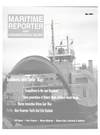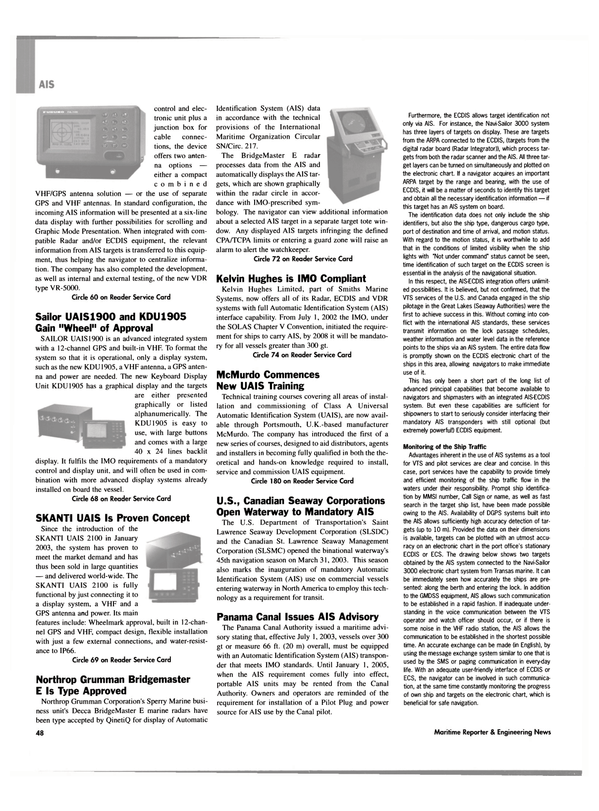
Integration Of AIS And ECDIS: More Information, Better View, Improved Safety
Ever since the requirements set forth in the new Chapter 5 of S0LAS-74 Convention, adopted in IMO Resolution MSC.99(73) dd. December 5, 2000, came into effect, the AIS (Automatic Identification System) has been mandatory ship equipment for a major part of the world's sea fleet. On the whole, AIS systems, just like electronic chart systems (ECDIS and ECS) and other navigation aids, are intended for the improvement of safety at sea. As the AIS market is currently at the development stage, and holds quite definite prospects, we will consider the practical use of the AIS by ship handlers, as well as the practical advantages and feasibility of integrating AIS with electronic chart systems.
Legally, according to the IMO recommendations and rules, the AIS system should have a control panel in the form of a MKD (Minimum Keyboard Display). But at the same time, standard documents allow the AIS to be connected to the external navigational system (e.g., ECDIS) without a MKD, if the latter itself provides the MKD functionality. Many shipowners will consider it a waste to invest in an ECDIS/ECS with a built-in MKD functionality for the AIS, the more so given that the cost of a chart system (like an ECDIS) is considerably higher than that of an MKD. But in the practical application, the effectiveness of AIS - ECDIS system integration is obvious, and we are sure to see its rise in the future.
Collision Avoidance and Surveillance In this respect, AIS-ECDIS system has indisputable advantages over other navigation aids like ARPA or radar. Firstly, because the AIS system operating range is the VHF range in the area. This is almost equivalent to the range, which the ARPA or radar operate in. Secondly, the ARPAAadar will only be able to show relative target mark on the screen by the bearing and range from own ship, whereas the ECDIS allows the target coordinates, its actual dimensions, full list of identifiers (Name, Call Sign, MMSI, IMO number) to be accurately determined and the collision avoidance information for this target (bearing and range to the target, CPA distance and TCPA time) to be promptly obtained. It is also possible to rapidly view additional information (Voyage Data) on the target for any moment in time. If there is a risk of collision with a target or of getting dangerously close to it, the ECDIS operator can quickly identify dangerous targets, obtain their parameters and promptly establish communication with these targets by transmitting a message via the AIS (Safety message) should the target fail to respond to the voice call on the VHF. Data on the messages transmitted from the ECDIS via AIS communication is archived in the ECDIS and will prove to be useful should an accident be considered in a court of law.
Furthermore, the ECDIS allows target identification not only via AIS. For instance, the Navi-Sailor 3000 system has three layers of targets on display. These are targets from the ARPA connected to the ECDIS, (targets from the digital radar board (Radar Integrator)), which process targets from both the radar scanner and the AIS. All three target layers can be turned on simultaneously and plotted on the electronic chart. If a navigator acquires an important ARPA target by the range and bearing, with the use of ECDIS, it will be a matter of seconds to identify this target and obtain all the necessary identification information — if this target has an AIS system on board.
The identification data does not only include the ship identifiers, but also the ship type, dangerous cargo type, port of destination and time of arrival, and motion status.
With regard to the motion status, it is worthwhile to add that in the conditions of limited visibility when the ship lights with "Not under command" status cannot be seen, time identification of such target on the ECDIS screen is essential in the analysis of the navigational situation.
In this respect, the AIS-ECDIS integration offers unlimited possibilities. It is believed, but not confirmed, that the VTS services of the U.S. and Canada engaged in the ship pilotage in the Great Lakes (Seaway Authorities) were the first to achieve success in this. Without coming into conflict with the international AIS standards, these services transmit information on the lock passage schedules, weather information and water level data in the reference points to the ships via an AIS system. The entire data flow is promptly shown on the ECDIS electronic chart of the ships in this area, allowing navigators to make immediate use of it.
This has only been a short part of the long list of advanced principal capabilities that become available to navigators and shipmasters with an integrated AIS-ECDIS system. But even these capabilities are sufficient for shipowners to start to seriously consider interfacing their mandatory AIS transponders with still optional (but extremely powerful!) ECDIS equipment.
Monitoring of the Ship Traffic Advantages inherent in the use of AIS systems as a tool for VTS and pilot services are clear and concise. In this case, port services have the capability to provide timely and efficient monitoring of the ship traffic flow in the waters under their responsibility. Prompt ship identification by MMSI number, Call Sign or name, as well as fast search in the target ship list, have been made possible owing to the AIS. Availability of DGPS systems built into the AIS allows sufficiently high accuracy detection of targets (up to 10 m). Provided the data on their dimensions is available, targets can be plotted with an utmost accuracy on an electronic chart in the port office's stationary ECDIS or ECS. The drawing below shows two targets obtained by the AIS system connected to the Navi-Sailor 3000 electronic chart system from Transas marine. It can be immediately seen how accurately the ships are presented: along the berth and entering the lock. In addition to the GMDSS equipment, AIS allows such communication to be established in a rapid fashion. If inadequate understanding in the voice communication between the VTS operator and watch officer should occur, or if there is some noise in the VHF radio station, the AIS allows the communication to be established in the shortest possible time. An accurate exchange can be made (in English), by using the message exchange system similar to one that is used by the SMS or paging communication in every-day life. With an adequate user-friendly interface of ECDIS or ECS, the navigator can be involved in such communication, at the same time constantly monitoring the progress of own ship and targets on the electronic chart, which is beneficial for safe navigation.
Read Integration Of AIS And ECDIS: More Information, Better View, Improved Safety in Pdf, Flash or Html5 edition of May 2003 Maritime Reporter
Other stories from May 2003 issue
Content
- NASSCO Delivers First of ORCA Class page: 10
- Aerodynamic Garage Ships page: 12
- RoPax Milestone page: 14
- Safe Boats Wins 700- Boat, $145-M Contract page: 17
- "I'm Looking Through You" page: 18
- Damen Offers Disaster Prevention Vessels page: 22
- NCL Acquires S/S United States page: 23
- Farstad Shipping Goes Big page: 24
- Frontline Continues to Blaze a Path page: 24
- Solid Roots to Withstand Future Storms page: 25
- The Best of Both Worlds page: 26
- MP: Eying Patrol Potential page: 30
- DNV Maritime: Changing of the Guard page: 31
- Small Tankers, Huge Market Potential page: 33
- Knutsen OAS Shipping Leads Gas Shipping Charge page: 34
- Nor-Shipping 2003: Bigger Than Ever page: 37
- Tribon M2 Enhanced Again page: 39
- Optimized Data Communication at Bergesen page: 39
- SES Electrical Sees Bright Future page: 39
- An Innovative LNG Carrier Concept page: 40
- A Multi-Billion Opportunity page: 40
- The Wartsila Dual-Fuel Engine page: 41
- Aluminum Gone "Bad" page: 42
- Integration Of AIS And ECDIS: More Information, Better View, Improved Safety page: 46
- Robert Allan: Naval Architecture is in the Blood page: 50
- Custom Solutions page: 52
- The Big One: L.A. Fireboat 2 page: 53
- Propulsion Stays Firmly Based on Diesel Engines page: 54
- Bunker Industry Fueled by Word Affairs page: 56
- Lube Oils on Test page: 57
- EMMIF: Getting Heavy With Bunkers page: 58
- Onboard-Napa Power Yields Fuel Savings page: 58
- Algae-X — Optimal Fuel and Oil Quality page: 61


